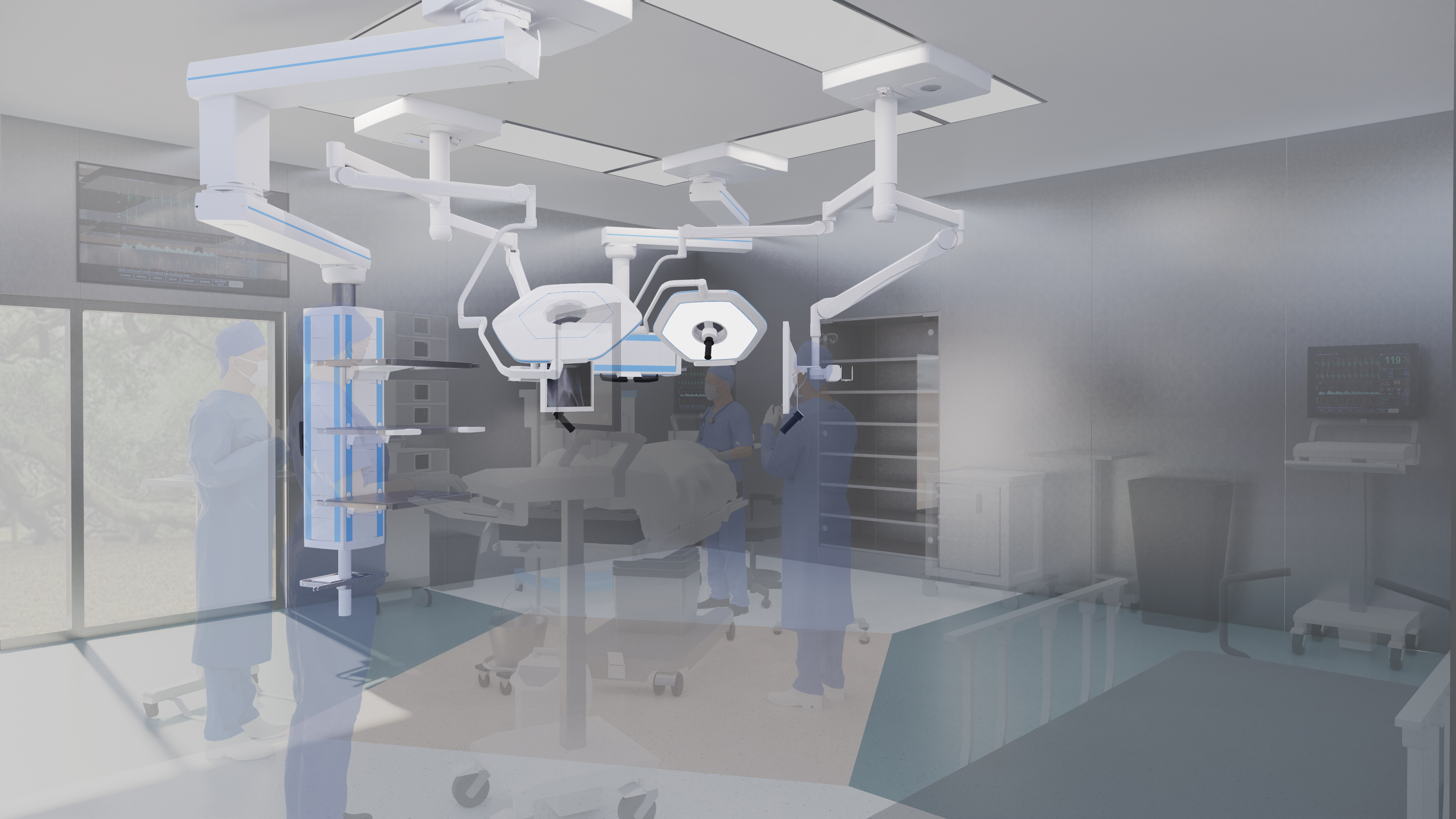TYPE OF STRATEGIES
To view citation, click on desired outcomes below.
Overhead booms that are positioned to minimize entanglement between boom components support improved surgical team members workflow.
DESIRED OUTCOMES/CITATIONS
Peer-reviewed (empirical study)
Matern & Koneczny, 2007
Matern, U., & Koneczny, S. (2007). Safety, hazards and ergonomics in the operating room. Surgical endoscopy, 21(11), 1965-1969.
Peer-reviewed (empirical study)
Watkins et al., 2011
Watkins, N., Kobelja, M., Peavey, E., Thomas, S., & Lyon, J. (2011). An evaluation of operating room safety and efficiency: Pilot utilization of a structured focus group format and three-dimensional video mock-up to inform design decision making. HERD: Health Environments Research & Design Journal, 5(1), 6-22.
Peer-reviewed (empirical study)
Knulst et al., 2011
Knulst, A. J., Mooijweer, R., Jansen, F. W., Stassen, L. P., & Dankelman, J. (2011). Indicating shortcomings in surgical lighting systems. Minimally Invasive Therapy & Allied Technologies, 20(5), 267-275.
Peer-reviewed (empirical study)
Knulst et al., 2011
Knulst, A. J., Mooijweer, R., Jansen, F. W., Stassen, L. P., & Dankelman, J. (2011). Indicating shortcomings in surgical lighting systems. Minimally Invasive Therapy & Allied Technologies, 20(5), 267-275.
TYPE OF STRATEGY
Task Technology Built EnvironmentCeiling mounted booms with integrated power, data, and medical gas outlets support cord management by keeping cords off of the floor.
DESIRED OUTCOMES/CITATIONS
Peer-reviewed (empirical study)
Patkin, 2003
Patkin, M. (2003). What surgeons want in operating rooms. Minimally invasive therapy & allied technologies, 12(6), 256-262.
Best Practice report (non peer-reviewed)
Joseph & Allison, 2018
Joseph, A. & Allison, D. (2018). Designing A Safer OR. Healthcare Design Magazine. Available at https://www.healthcaredesignmagazine.com/trends/research-theory/designing-a-safer-or/
Peer-reviewed (empirical study)
Patkin, 2003
Patkin, M. (2003). What surgeons want in operating rooms. Minimally invasive therapy & allied technologies, 12(6), 256-262.
Peer-reviewed (empirical study)
Patkin, 2003
Patkin, M. (2003). What surgeons want in operating rooms. Minimally invasive therapy & allied technologies, 12(6), 256-262.
Best Practice report (non peer-reviewed)
Joseph & Allison, 2018
Joseph, A. & Allison, D. (2018). Designing A Safer OR. Healthcare Design Magazine. Available at https://www.healthcaredesignmagazine.com/trends/research-theory/designing-a-safer-or/
Peer-reviewed (best practice, design guidelines, or literature review report)
Brogmus et al., 2007
Brogmus, G., Leone, W., Butler, L., & Hernandez, E. (2007). Best practices in OR suite layout and equipment choices to reduce slips, trips, and falls. AORN journal, 86(3), 384-398.
Peer-reviewed (empirical study)
Ofek et al., 2006
Ofek, E., Pizov, R., & Bitterman, N. (2006). From a radial operating theatre to a self‐contained operating table. Anaesthesia, 61(6), 548-552.
Peer-reviewed (empirical study)
Worley & Hohler, 2008
Worley, D. J., & Hohler, S. E. (2008). OR construction project: from planning to execution. AORN journal, 88(6), 917-941.
Best Practice report (non peer-reviewed)
Lee, 2015
Lee, K. (2015). Designing The OR Of The Future. Healthcare Design Magazine. Available at https://www.healthcaredesignmagazine.com/trends/construction-engineering/designing-or-future/?hilite=%27designing%27%2C%27Future%27
Peer-reviewed (empirical study)
Patkin, 2003
Patkin, M. (2003). What surgeons want in operating rooms. Minimally invasive therapy & allied technologies, 12(6), 256-262.
Peer-reviewed (empirical study)
Patkin, 2003
Patkin, M. (2003). What surgeons want in operating rooms. Minimally invasive therapy & allied technologies, 12(6), 256-262.
Best Practice report (non peer-reviewed)
Joseph
Joseph, A. & Allison, D. (2018). Designing A Safer OR. Healthcare Design Magazine. Available at https://www.healthcaredesignmagazine.com/trends/research-theory/designing-a-safer-or/
TYPE OF STRATEGY
TechnologyEvaluating boom mount locations for impact on airflow disturbances over the OR table supports reduced turbulence and uniform airflow above the OR table.
DESIRED OUTCOMES/CITATIONS
Best Practice report (non peer-reviewed)
Lee, 2015
Lee, K. (2015). Designing The OR Of The Future. Healthcare Design Magazine. Available at https://www.healthcaredesignmagazine.com/trends/construction-engineering/designing-or-future/?hilite=%27designing%27%2C%27Future%27
TYPE OF STRATEGY
Technology Built EnvironmentBooms with adjustable features, such as articulating arms and height adjustment, support the ability to perform multiple surgical procedures from different specialties in the same OR.
DESIRED OUTCOMES/CITATIONS
Peer-reviewed (best practice, design guidelines, or literature review report)
Worley & Hohler, 2008
Worley, D. J., & Hohler, S. E. (2008). OR construction project: from planning to execution. AORN journal, 88(6), 917-941.
TYPE OF STRATEGY
Task Technology



